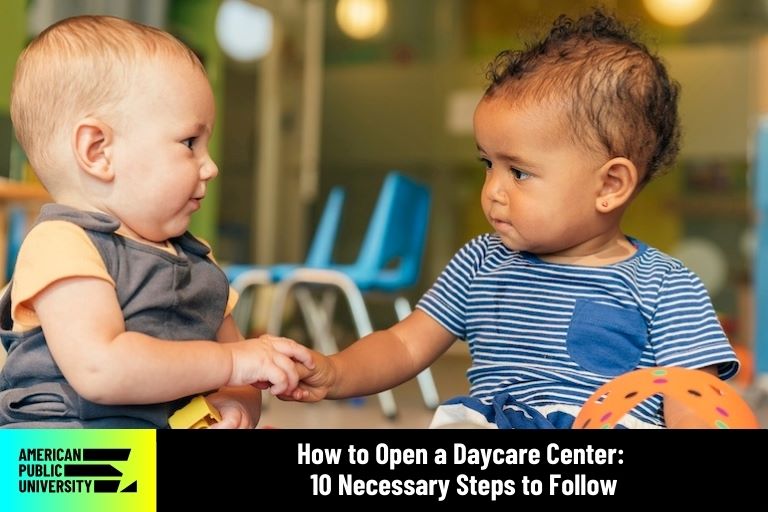By Kate Zuritsky | 04/23/2025

Does the pitter-patter of little feet and squeals of joy bring a smile to your face? If you’re passionate about early childhood education, want to make a difference in kids' lives, and help their parents, you should investigate how to open a daycare center (also known as a childcare business).
As remote work winds down and return-to-office mandates ramp up, families are left with the need to seek affordable childcare. Working parents’ childcare challenges are worsening, and important questions have surfaced, such as:
- Can either parent afford to stop working?
- Is in-home daycare an option?
- Should the kids go to daycare?
While childcare providers have always been in demand, sudden return-to-office (RTO) mandates issued by corporations and government agencies have led to stressed parents and career disruptions. Now could be the ideal moment to consider becoming a daycare business owner.
“Opening a childcare center is a very specific undertaking that varies from state to state,” explains Kathleen L. Mangeri, a licensed professional counselor and the Department Chair of the Human Development and Family Studies Program at American Public University. “Some states have an extensive licensing and permitting process while others have minimum requirements.”
If you’re a person who loves children, values flexibility, and dreams of owning your own business, opening your own childcare may be perfect for you.
Why Affordable Childcare Is So Important
Providing affordable childcare is highly important to many parents. According to Grand View Research, the U.S. childcare market was worth $61.70 billion in 2023 and will continue to grow at a rate of 5.86% from 2024 to 2030.
In addition, approximately 67.8% of U.S. children under 6 (about 14.4 million) come from a dual-working household. With sudden return-to-office (RTO) mandates and more couples joining the workforce, affordable and easily accessible childcare is essential.
“Before embarking on achieving your goal of opening a childcare business, one of the first decisions that you will need to make is whether your childcare business will be home-based or center based,” states Mangeri. “A home-based childcare center, also known as a family childcare home, is one that cares for a limited number of children in a residential setting, often your own home.” By contrast, a center-based childcare business serves a larger number of children of children in a commercial-type space.
According to Mangeri, there are 10 steps to consider as you build your daycare business:
- Identify who you’ll serve
- Construct the right learning environment
- Prepare a budget
- Determine a location
- Explore funding and financing
- Investigate regulations and requirements
- Identify insurance and permits
- Devise a marketing and business plan
- Set realistic and attainable business goals
- Make your dream a reality
Step 1: Identify Who You’ll Serve
The first step is to “assess the need for childcare in your area,” Mangeri states. For a daycare business, you’ll need to consider factors such as the number of childcare services or in-home care providers already in your community and the age group you wish to serve.
Conducting an assessment and performing research online will help you better understand the local demand for services and your target demographic. Whether you want to care for infants, toddlers, or preschoolers, make sure your business meets community needs and regulatory standards.
Step 2: Construct the Right Learning Environment
It’s essential to construct an open, inviting early childhood learning environment for children. Make sure there’s enough space for everyone to socialize, play, and learn without overcrowding.
According to Mangeri, you must also ask yourself these questions prior to opening a daycare business:
- How many children can you accommodate?
- What are the ages of the children you will serve?
- How many rooms will you need?
- Does your daycare require outdoor space?
- Will you need a meal preparation space?
- Do you know how to care for sick children if necessary?
- Does your license permit you to care for sick children?
- What hours do you plan to be open?
Step 3: Prepare a Budget
Financial planning is essential and can determine your long-term success if you want to open your own daycare. You’ll need to figure out your startup and ongoing costs and prepare a budget. It is also crucial to account for one-time startup business expenses such as equipment, furniture, licenses, and permits.
Mangeri also suggests considering the cost of hiring additional staff and whether you lease or purchase your space. You'll need a solid plan in order to handle your business finances.
Step 4: Determine a Location
The location of your daycare can directly influence your enrollment. “The more centrally located you are to the need for childcare services, the easier it will be to attract clients,” explains Mangeri. “The location must meet the zoning requirements for a childcare business. Zoning requirements are set by the local city or municipality.”
You’ll also need to consider accessibility. Some of the children in your daycare – or their caregivers – might use wheelchairs or crutches, so you’ll need to plan for a safe way to enter and leave your daycare center.
Step 5: Explore Funding and Financing
To minimize expenses, find out whether you could secure external funding through small business loans, grants, or childcare-specific subsidies. You may also be eligible for federal and state subsidy programs if you target lower-income families, depending on “requirements for your program to be able to accept childcare subsidies,” suggests Mangeri.
Step 6: Investigate Regulations and Requirements
Mangeri advises budding childcare center owners to “investigate the specific regulations and requirements for securing a childcare license in your state. In addition to paperwork requirements and licensing fees, some states require specific training before the license is issued and additional training to maintain licensure.”
Each state’s department enforces specific daycare licensing requirements for health, safety, and staffing. Failure to comply may lead to fines, training mandates, or a revoked business license.
A background check and certain certifications connected to early childhood education may also be required, such as:
- A Child Development Associate (CDA) credential
- A current CPR certification
- An associate or bachelor's degree for certain positions within the childcare center
Step 7: Identify Insurance and Permits
Mangeri says it’s essential to “identify the insurances and permits necessary to open a childcare center in your area.” Licensing, permits, and insurance are among the most important steps for your business venture, and they will protect your business should anything occur.
To open your business facility, you’ll need to obtain a professional childcare license, which will show that you’ve met the minimum requirements for health and safety. You’ll also need a business license, zoning permits, and a building permit.
It’s also critical to ensure your childcare service has the right kind of insurance. Some of the most common types of insurance include business owner insurance, professional liability insurance, and workers’ compensation.
Remember that licenses, permits, and insurance requirements of opening your own daycare centers vary by state. Some states may also require additional compliance with zoning laws, health inspection, and certificates of occupancy.
Step 8: Devise a Marketing and Business Plan
Determine what makes your daycare unique and make informed decisions about what may help you stand out from the crowd. “A business plan is an essential roadmap for a childcare center,” advises Mangeri. “Typically, our early childhood education students are tasked with researching the requirements of creating a center in the city or state where they wish to operate their business.”
While you may think your childcare service is exceptional, no one will know about it if you don’t advertise it accordingly. That’s why you should incorporate public relations and marketing strategies in advance, so everyone knows you exist and why they should choose your daycare.
Come up with a creative name for your business, design a logo, and build a website and social media pages so you have an online presence. You can also join forces with local businesses to advertise and get featured in newspapers and magazines.
Your marketing and business plan should include:
- Your business format: a sole proprietorship, limited liability company, or an S corporation
- The type of program you offer: Full-day, half-day, or after-school
- Your learning philosophy and any additional services you intend to provide
- Your mission statement
- Your short-term and long-term business goals
- Your pricing strategy
- Your operational plan
- Your start-up fees, expenses, and plans to secure funding
- Your marketing strategy and potential partnerships
Step 9: Set Realistic and Attainable Business Goals
“Identify realistic and attainable business goals for your childcare center,” advises Mangeri. This strategy will create benchmarks for your business operations and help you manage your business properly.
Examples of potential business goals might include:
- Increasing enrollment by 20% in your first year
- Launching a new after-school program
- Hiring two additional staff members within six months
- Offering additional family services as the business grows
Once you’ve identified your goals, break them into “Specific, Measurable, Achievable, Relevant, and Time-Bound” (SMART) objectives that align with your short-term and long-term goals. Make sure to set deadlines and hold yourself accountable.
Step 10: Make Your Dream a Reality
“After you've taken all of the necessary steps for your small business, it's time to move your plan from paper to reality,” advises Mangeri. Once you’ve chosen an opening date, consider hosting an opening party or an open house at your facility to get foot traffic from children and adults who may want to attend the event.
Be sure to include activities that will allow you to showcase your skills and attract potential clients in your target audience. For example, prepare interactive activities for children and hand out branded gift bags that include your logo, contact information, business details, and a few fun giveaway items. Also, don’t forget to start submitting your business to local directories and family resource networks to maximize your advertising reach.
The Early Childhood Care and Education Degree at American Public University
For adult learners who seek a knowledge of early childhood education, American Public University (APU) offers an online Associate of Arts in Early Childhood Care and Education. Taught by expert instructors, courses in this program feature topics such as childhood educational development, infant and toddler programs, and infant-toddler development. Other courses cover parenting, observation techniques, and an introduction to the American family.
For more information, visit APU’s education degree program page.
Note: This program does not award professional licensure and does not qualify you to apply for teaching licensure. This program may be helpful as you prepare to earn certain professional certifications.

